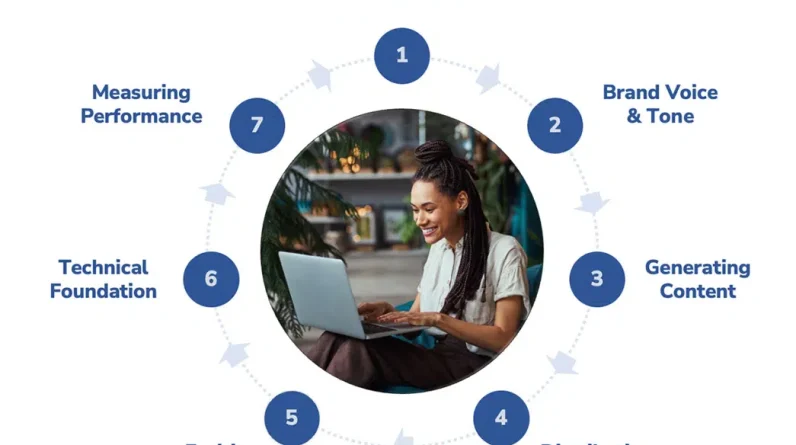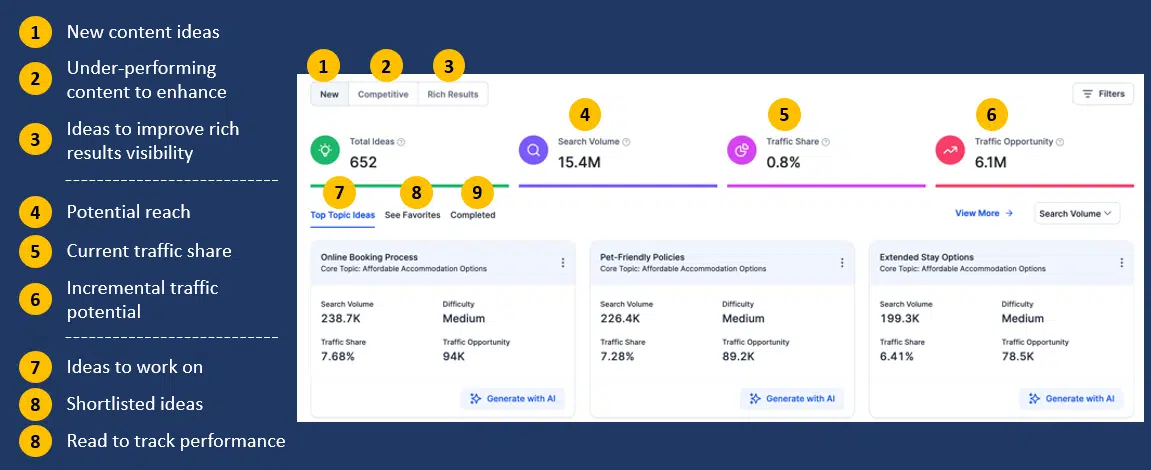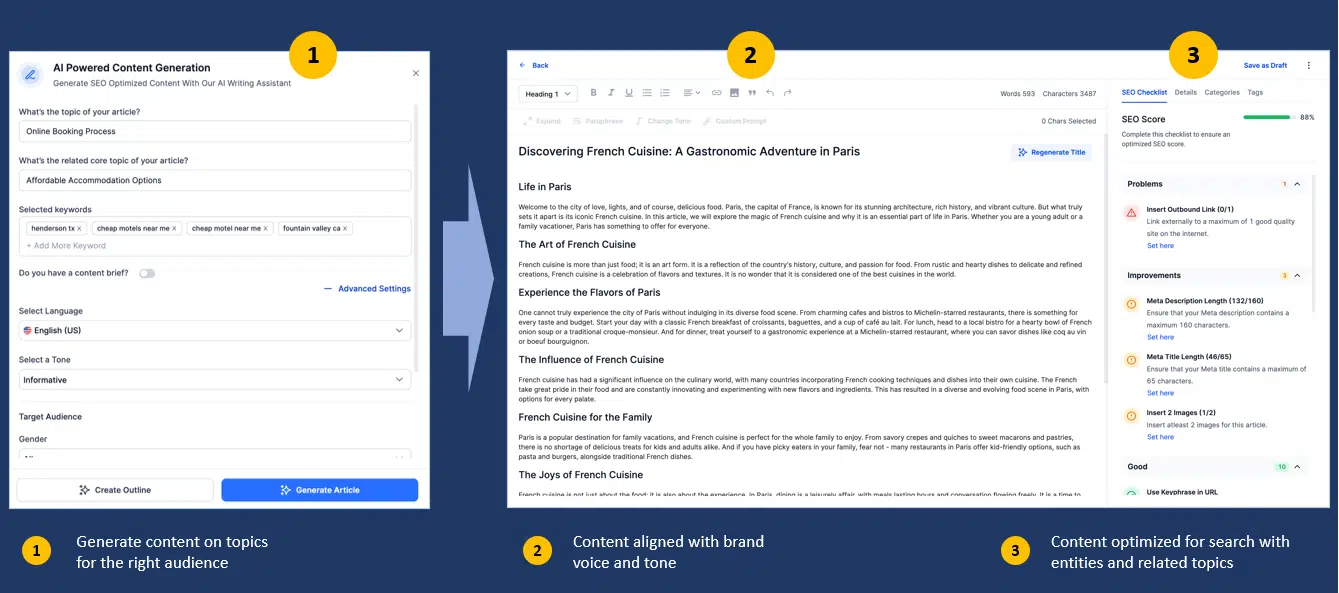
With Google’s increasing focus on reducing low-quality content in search results, marketers are questioning the role of AI-generated content. However, regardless of how it is created, Google’s main concern is content quality and user-friendliness. As long as the content provides value, experience and a good user experience, the method of creation doesn’t matter.
This article presents a seven-step process for scaling content production through the strategic integration of AI, while ensuring the output meets Google’s standards for high-quality, audience-centric content.
Google’s position on content and AI
Google’s position on content prioritizes user-centricity, emphasizing its quality, usefulness and authority. This focus is reflected in Google’s algorithm updates, which focus on improving user experience and relevance. Content creators should prioritize crafting valuable, expertly crafted content that delivers a seamless on-page experience.
While Google’s guidelines do not dictate specific creation methods, they emphasize the importance of user value. Effective content strategies can leverage AI alongside human insights to produce high-quality, people-centric content.
Dig Deeper: Google’s Changing Approach to AI Content: An In-Depth Look
A 7-step process for scaling content with AI
How can you create great content that adheres to these guidelines while using AI as a tool to scale? It starts with building the right foundation and understanding your audience. Crafting high-quality, user-friendly, search engine-friendly content that drives business revenue is now more complex.
As generative AI models like Gemini, ChatGPT, LLaMA and others continue to learn from content published on websites, creating the right useful content that answers user queries is paramount. Identifying the right topics for content, creating it with a consistent brand voice, and targeting the right end audience takes time and resources.
We’ve outlined seven steps for brands to create effective content plans with AI. These steps cover everything from brainstorming to measuring success, ensuring your content is valuable to users and performs well in search.
Knowing what to write (content intelligence). Map the brand voice, tone and journey for content. Content generation with themes and brand voice. Content optimization for entities and related topics. Establishment of content distribution workflows. Guarantee the experience of the page, the technical basis. Performance measurement and analysis (content analysis).
Step 1: Know what to write (content intelligence)

Content intelligence aims to provide data-rich information to the user to help them make informed decisions. The biggest hurdle for content creators is knowing what content will resonate with audiences and perform well.
Creating a high impact content strategy takes research, data and time. Start by identifying your customers’ problems and crafting compelling topics and subtopics. Analyze existing content, competitor content, and AI-assisted search trends to identify gaps, strengths, and opportunities.
With this information, marketers can develop a content roadmap, prioritizing what’s working well, what needs improvement, and what new content is needed.
Step 2: Map the brand voice, tone, and journey for content
Ensuring a consistent brand voice across multiple content platforms such as web, email, social media and paid campaigns is a challenge for any brand.
Ideally, AI initiatives should analyze and understand your brand voice and audience preferences, creating a concise guide that describes your audience’s tone, language, and personas.
This becomes the blueprint for content creation, guiding teams to produce brand-consistent and audience-aligned content across all channels.
Step 3: Content generation with themes and brand voice
Writing and editing for brand consistency is time-consuming, but essential. By identifying gaps in content and a clear brand voice, AI can quickly incorporate ideas, specific phrases, insights from authoritative sites, audience interests, and relevant data such as events or pricing to generate content sketches or drafts in matter of seconds
This approach saves time by shifting the focus to refining and improving content for consistency and impact.

By leveraging AI, creators can generate a wide range of content tailored to the needs of their audience. Here are several vertical specific examples:
Some use cases for the hospitality industry include suggested travel itineraries, promotional materials, blogs, social posts, and landing pages about local events and things to do. In healthcare, AI can help create patient education materials, research summaries and health advice articles. Banking content creators can use AI to demystify financial concepts through informative articles, market updates and personalized investment advice. Automotive content creators can leverage AI to produce detailed car reviews, maintenance tips, and industry news articles.
The goal is to ensure that all AI-powered content is contextually relevant by introducing custom variables such as topics, keywords, brand voice, target audience, etc.
Get the daily search newsletter marketers trust.
Step 4: Optimizing content for related entities and topics
Content is only effective when it is discoverable, relevant and provides an experience to your target audience. Establishing quick guidelines helps ensure your output meets best practices such as content quality, length, meta information, topics, subtopics, and entities.
Running a robust checklist simplifies the process of quickly checking what AI tools got right and what human editors need to improve.
Ideally, AI tools should have pre-built advanced prompting, an SEO checklist, and workflows to optimize the generated content so authors can create better quality results.
Step 5: Establish content distribution workflows
Once you’ve created good quality content, you need to ensure a rock-solid experience across all channels and locations.
AI-assisted content should flow seamlessly through the distribution workflow, which could involve publishing directly to your CMS or exporting it in various formats for integration into standard workflows.
Ensure that all media assets, such as images and PDFs, are included to maintain a consistent, high-quality user experience across all platforms. Workflows for translating content into multiple languages should also be part of content distribution journeys.
Step 6: Secure the page experience, the technical foundation
A website’s page experience directly affects user satisfaction. Slow loading pages increase bounce rates and hurt engagement.
Pay attention to your main web features and improve your site’s performance. A solid technical setup ensures a safe and user-friendly site. Together, these elements improve user retention, engagement and conversions.
Step 7: Performance measurement and analysis (content analysis)
If you can’t measure it, you can’t improve it. Identifying the right KPIs before publishing content is important to ensure the analytics data layer is in place to see and validate impact. Analyzing content reach and effectiveness is essential to creating a feedback loop for content intelligence.
By closing content gaps, you’ll gain valuable insight into what topics or types of content you should focus on next. This allows you to keep moving the needle on discovery and revenue.
Integrating AI into every part of this seven-step strategic approach to content creation allows for scale in this evolving landscape. From identifying the most impactful ideas to generating rich, optimized content to publishing and measuring results, integrating AI enables efficient, targeted and measurable quality content creation.
Dig Deeper: How to protect your content strategy in an AI-driven search landscape
The views expressed in this article are those of the guest author and not necessarily Search Engine Land. Staff authors are listed here.
[ad_2]
Source link




